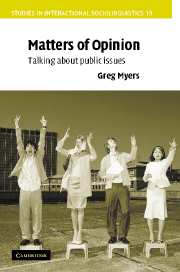Book contents
- Frontmatter
- Contents
- Acknowledgments
- Transcription conventions
- Focus-group data
- 1 Paradoxes of opinion
- 2 A tool kit for analysing group discussions
- 3 Forums for opinion: ‘What is it that's going on here?’
- 4 Institutions of opinion: voice of the people?
- 5 Topics in interaction: ‘Why that now?’
- 6 Agreeing and disagreeing: maintaining sociable argument
- 7 Representing speech: other voices, other places
- 8 Questioning expertise: Who says?
- 9 Radio phone-ins: mediated sociable argument
- 10 Vox pop television interviews: constructing the public
- 11 Opinions as talk
- References
- Index
5 - Topics in interaction: ‘Why that now?’
Published online by Cambridge University Press: 22 September 2009
- Frontmatter
- Contents
- Acknowledgments
- Transcription conventions
- Focus-group data
- 1 Paradoxes of opinion
- 2 A tool kit for analysing group discussions
- 3 Forums for opinion: ‘What is it that's going on here?’
- 4 Institutions of opinion: voice of the people?
- 5 Topics in interaction: ‘Why that now?’
- 6 Agreeing and disagreeing: maintaining sociable argument
- 7 Representing speech: other voices, other places
- 8 Questioning expertise: Who says?
- 9 Radio phone-ins: mediated sociable argument
- 10 Vox pop television interviews: constructing the public
- 11 Opinions as talk
- References
- Index
Summary
‘Hold on, are we still talking about sex?’ The not too bright Joey asks this in the second episode of Friends after the other characters have developed an elaborate extended metaphor comparing foreplay to the opening act at a rock concert. The joke is that he needed to ask. Unlike classroom lessons, parliamentary debates, or this book, conversation does not come with a gloss to tell us, at any moment, what it is supposed to be about. Yet participants in a conversation usually assume that it is about something and make contributions relevant to this something, even if they seldom name what they are talking about unless there is some confusion, or unless a new person enters the room. But as soon as one looks at a transcript, one can see that this apparent simplicity covers very complex moment-to-moment negotiations by the participants. And most people have had the experience of joining in a conversation only to discover that their contribution is puzzlingly, humorously, or offensively unrelated. Tom Stoppard's plays, the mock interviews of the British comedian Ali G, and some classic routines of the Marx Brothers all rely on this slippage.
In this chapter, I argue that there are problems in any attempt to code this flow of topics in focus groups into the researchers' categories, to make them into discrete opinions.
- Type
- Chapter
- Information
- Matters of OpinionTalking About Public Issues, pp. 89 - 111Publisher: Cambridge University PressPrint publication year: 2004



